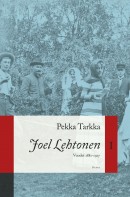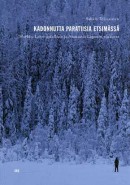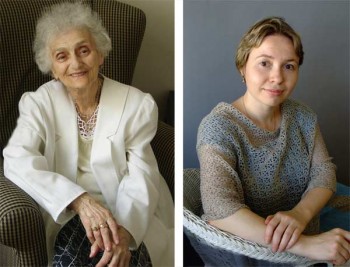Archive for August, 2009
A roof with a view
27 August 2009 | Fiction, Prose
Extracts from the novel Mistä on mustat tytöt tehty? (‘What are black girls made of?’, Tammi, 2009) Introduction by Tuomas Juntunen
I’m a chimney sweep’s daughter, born October 1962 as a gift, a light to a darkened world. I’ve had lots of mothers, but none of them ever stuck around for good. One of them gave birth to me, so she’s Mother, not mother. Her name is Dewdrop, because water has spilled over the only photograph of My Mother and now her face has dissolved into a single translucent droplet; her nose, cheeks and chin are now a fat, shiny blob that looks like it’s about to fall out of the bottom of the picture. More…
Translation prize
20 August 2009 | In the news
This year the Finnish Government Prize for Translation of Finnish Literature, worth €10,000, was divided between two Russian translators. Lyudmila Braude and Anna Sidorova received their awards in Helsinki on 12 August from the minister of culture and sports, Stefan Wallin.
Braude was born in Leningrad in 1927, Sidorova half a century later in Vyborg, in 1978.
Dr Lyudmila Braude specialised in the translation of German and Nordic literature. Since 1991 she has translated Finland-Swedish fiction, Tove Jansson’s works in particular; all Jansson’s Moomin books as well as a selection of her novels and stories for adults are available to Russian readers. Books by the classic children’s writer Zachris Topelius as well as Finland-Swedish poetry by classic and contemporary poets have also been among her translations. Braude has received various international prizes for her work. More…
Jarkko Nieminen: Pelaamisen lumo [The fascination of the game]
20 August 2009 | Mini reviews, Reviews
 Pelaamisen lumo [The fascination of the game]
Pelaamisen lumo [The fascination of the game]
Helsinki: Avain, 2009. 175 p., ill.
978-952-5524-69-7
€ 38, hardback
Tennis is a curious game, as everyone who plays it knows – and even those who don’t, which is why it is such a popular sport. Although Jarkko Nieminen (born 1981), a professional player since 2000, has not yet won a Grand Slam event for Finland, in 2006 he was ranked no. 13. (Unfortunately, this spring Nieminen injured his wrist and missed the top matches of the season.) In this book (edited and published by his sister Anna-Riikka Carlson, who founded the publishing company Avain in 2003), Nieminen tells the story of his athletic career. ‘In Japan my visa said I was an “entertainer”,’ he recalls as he describes what it’s like to walk out on a court filled with thousands of spectators. Tennis is a gentleman’s game, a polite duel (or double), and Nieminen is certainly a gentleman par excellence. His personal story is designed to be strictly informative, as he chooses to keep his family life private, for example (his wife Anu, née Weckström, a Finnish multiple badminton champion, is referred to once). There is no doubt, though, that the reader will be convinced of Nieminen’s happy choice of an athletic profession.
Julia Donner & Taneli Eskola: Löytöretki Helsinkiin. Exploring Helsinki. Helsingfors på upptäcktsfärd
20 August 2009 | Mini reviews, Reviews
 Löytöretki Helsinkiin. Paikkoja, polkuja, puutarhoja. Exploring Helsinki. Places, paths, gardens. I Helsingfors på upptäcktsfärd. Platser, stigar, trädgårdar
Löytöretki Helsinkiin. Paikkoja, polkuja, puutarhoja. Exploring Helsinki. Places, paths, gardens. I Helsingfors på upptäcktsfärd. Platser, stigar, trädgårdar
Helsinki: Multikustannus, 2008. 167 p., ill.
ISBN 978-952-468-147-6
€ 42, hardback
In this book, author Julia Donner and photographer Taneli Eskola make a walking tour of the less familiar byways of their native Helsinki, in the changing seasons between 2007 and 2008. Donner quotes authors and poets while recording some of the city’s history. She takes the reader through places often ignored – small, modest enclosures between buildings that only just qualify for the name of parks, suburban parklands or the rocky spaces that have been left untouched in the heart of the city. Eskola’s photographs record the graphic details of frost and sleet as well as the first tinges of spring green, of flora, rocks, water and sky. Some of the text is printed in both Swedish and English. A map would have been useful to readers who are not familiar with Helsinki; some of the photographs also lack captions. This beautiful book, designed by Timo Numminen, is an original series of views that have not been prettified but are true to the everyday life of the city. And readers who live in Helsinki will be surprised by what they discover.
Pekka Tarkka: Joel Lehtonen 1. Vuodet 1881–1917 [Joel Lehtonen 1. The years 1881–1917]
13 August 2009 | Mini reviews, Reviews
 Joel Lehtonen 1. Vuodet 1881–1917
Joel Lehtonen 1. Vuodet 1881–1917
[Joel Lehtonen 1. The years 1881–1917]
Helsinki: Otava, 2009. 431 p., ill.
ISBN 978-951-1-23229-2
€ 37, hardback
The early years of the author Joel Lehtonen (1881–1934) were harsh ones: he was the illegitimate child of a mentally disturbed mother who abandonded her six-month-year baby in the forest. Fortunately Joel was adopted by a cultured clergyman who supported his education, making it possible for him to find a career in journalism and writing. The author and critic Pekka Tarkka published his doctoral dissertation on the changes in Joel Lehtonen’s view of human character in 1977. In this new book, the first general account of Lehtonen’s life and work, he presents an interesting view of the writer’s contradictory personality. Lehtonen’s travels in France, Italy and Switzerland strengthened his knowledge of foreign languages and his interest in Romance culture essential to his translator’s work. Lehtonen’s novels and short stories are often set in his home province of Savo, which he depicted through many phases of its social development. His most popular novel, Putkinotko, was published in 1919–1920. The first volume of Tarkka’s biography ends with Lehtonen’s writing in 1917 of the novel Kerran kesällä (‘Once in summer’), about a composer returning to Finland from abroad just as the Finnish Civil War is about to begin.
Sakari Toiviainen: Kadonnutta paratiisia etsimässä [In search of a lost paradise]
12 August 2009 | Mini reviews, Reviews
 Kadonnutta paratiisia etsimässä. Markku Lehmuskallion ja Anastasia Lapsuin
Kadonnutta paratiisia etsimässä. Markku Lehmuskallion ja Anastasia Lapsuin
elokuvat
[In search of a lost paradise. The films of Lehmuskallio and Anastasia Lapsui]
Helsinki: Finnish Literature Society, 2009. 274 p., ill.
ISBN 978-952-222-067-7
€ 28, paperback
Markku Lehmuskallio (born 1938) is a filmmaker and photographer who since 1973 has made 18 full-length feature films, as well as a number of shorter ones. A half of his work is a collaborative venture with his wife Anastasia Lapsui, who is a native of the Nenets region in Arctic Russia. The main subjects of his films are the relationship between people and nature, and indigenous cultures throughout the northern hemisphere. Lehmuskallio’s early work reflects his activity as a pioneer of the green movement, as his films from that period deal with the environmental threat to the forests. Lehmuskallio has also directed fiction films, including the first to be made in the Nenets language, the award-winning Seven songs from the tundra. He has documented the conflicts between indigenous and national cultures, such as the destruction of the environment of the Siberian peoples in the process of gas and oilfield exploration. The filmographer Sakari Toiviainen had access to original material ranging from brittle old reels of film to diaries; Lehmuskallio’s own voice comes through clearly in the text.
Pauli Kruhse & Antero Uitto: Suomea rajan takana 1918–1944 [Finnish on the other side of the border 1918–1944]
6 August 2009 | Mini reviews, Reviews
 Suomea rajan takana 1918–1944: Suomenkielisen neuvostokirjallisuuden historia ja bibliografia
Suomea rajan takana 1918–1944: Suomenkielisen neuvostokirjallisuuden historia ja bibliografia
[Finnish beyond the border 1918–1944: a history and bibliography of Finnish-language literature in Soviet Union]
Helsinki: BTJ Finland Oy, The Finnish National Library, 2008. 395 p., ill.
ISBN 978-951-692-705-6
€ 49, paperback
The Finnish National Library possesses an impressive collection of Finnish-language literature published in the Soviet Union; the Soviet Karelia Collection contains around 3,800 titles on political and social themes, as well as fiction and poetry. Some of the material was captured from the Soviets during the Continuation War of 1941–1944. The Library has also augmented the collection with material in Finnish, written by Finns or dealing with Finland, which has been published in Russia. Listed in the bibliography are 566 Soviet books published in Finnish and 270 in Karelian, as well as works in private collections – many of these are bibliophilic rarities as a result of the attempt to destroy Finnish identity and the Finnish language in the Soviet Union during Stalin’s purges of 1937–38.


